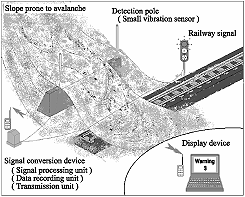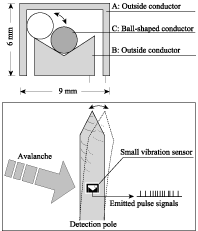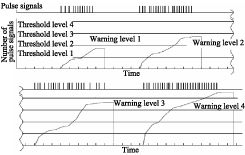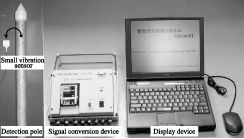 Fig.1 An image of the developed system installed on a track side |  Fig.2 A cross section of small vibration sensor and an image of emitted pulse signals |
| Shigehiro IIKURA Senior Researcher, | Katsuhisa KAWASHIMA Senior Researcher, | |
| Toru ENDO Researcher | Toshishige FUJII Senior Researcher, Laboratory Head, | |
| Meteorological Disaster Prevention, Disaster Prevention Technology Div. | ||
1. Introduction
In order to protect railways from avalanche damage effectively, we need to implement various avalanche prevention and protection works as hardware measure, including software measures to timely restrict operation of trains in hazardous areas. We Railway Technical Research Institute have developed a snow avalanche detecting system which is able to timely perform restriction of train operations appropriately and to support inspection and snow removal promptly once any avalanche occurs. This system features a function to detect occurrence of avalanches and deliver 4 grades of warning according to the importance of an occurring avalanche. Therefore, we can say that this is a very effective system to control train operation, by sending a warning of a certain level to the monitor station, and on the side of the monitor station, they can judge whether or not it is necessary to provide snow removal or inspection work on the site and to know the importance of these actions at an earlier stage.
2. How can an avalanche be detected?
This newly developed snow avalanche detecting system employs detection poles along the railway, able to detect occurrence of an avalanche, immediately when the poles vibrate at the moment the snow flow collide with them (Fig.1). Provided in the pole is a small vibration sensor which consists of two outer conductors under voltage (A, B in Fig.2) and one ball-shaped conductor (C in Fig.2). Normally, in the calm times, the two outer conductors are isolated from each other, but when subjected to vibration, the ball-type conductor moves, and generates short circuit and isolation between the two outer conductors to emit pulse signals.
 Fig.1 An image of the developed system installed on a track side |  Fig.2 A cross section of small vibration sensor and an image of emitted pulse signals |
3. Evaluation of the significance of an avalanche and setting of warning levels
The number of pulse signals from the vibration sensor when the detection poles start vibration at the moment of an avalanche, depends upon the impact force to the poles and the duration of the avalanche. In the event the impact force is large and the avalanche duration long, the number of emitted pulse signals increases. From this, for an avalanche, we can consider the total number of pulse signals as an index to denote the scale of an avalanche. Considering this relationship, the system has a significance scale of four output levels according to the number of pulse signals; threshold 1, threshold 2, threshold 3 and threshold 4. If any avalanche of certain scale occurs, it is evaluated to any of these four levels. When the number of pulse signals does not reach level 1, we consider there is no avalanche. Thanks to this mechanism, we can prevent outputting of an useless avalanche warning (erroneous detection), if the case concerned is vibration of detection poles due to a strong wind, small ground vibration and small snow fallings which are not likely to hinder operation of trains.

4. Composition of the system
This system is composed of detection poles, a signal conversion device and a display device (Fig.4). The detection pole is a hollow pipe of FRP (outer diameter 11 cm, inner diameter 10 cm and weight of one meter length 1.8 kg). In the pole, there exists a vibration sensor, as shown in Fig.2. The length of a detection pole is determined considering the maximum snow depth at the place at which its pole is installed.
For installing the pole, it is important to determine the most suitable place, considering potential courses along which an avalanche run down.
The signal conversion device is divided into three sections; signal processing unit, recording unit and transmission unit. The role of the signal processing unit is to determine the total number of pulse signals emitted from the vibration sensor, and to select a warning level according to the preset threshold. The signal processing unit also has a function to monitor breaking of the detection pole and failure of the wire between the signal conversion device and the detection pole. The transmission unit has the role to send to the display device various kinds of information including the hour when an avalanche occurs, the total number of pulse signals, the warning level selected as well as the information on equipment failures. When an avalanche occurs, it is possible to control railway signals on the site via the transmission unit. The data recording unit stores in a memory card the same information as that sent to the display. To one signal conversion device, it may be connected up to six detection poles, which perform the above processing for each of the detection poles separately.
The display device receives the information from the signal conversion device via telephone circuit, displays and store said information. Setting and change of each threshold can be made at the display device.

5. Operation test of the avalanche detecting system at the Kurobe Canyon
To confirm that this system may detect actual avalanche effectively, we had conducted a field test at a slope site prone to avalanche, at Shiaidani on the Kurobe Canyon, from November 1998 to June 1999. As a result of this field test, it was revealed that the system could detect a total of 8 avalanches during the same period. The occurrence hours of avalanches can be confirmed to be perfectly correct by collating them to the data from the avalanche impact pressure gauge and the video camera of Hokkaido University and Toyama University. During this test period, there occurred no erroneous detection due to high gales and so force, and the test demonstrated the system had an excellent practicality.